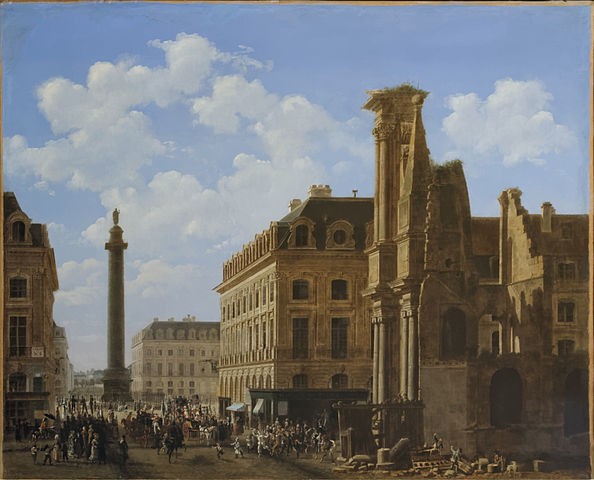Napoleon wanted Paris to become a modern city, and he launched major projects to improve the daily life of its 600,000 inhabitants. Some of the aims were to: improve the city’s lighting; pave the streets; create sewers; number the houses (using odd and even numbers, beginning at the Seine); align the buildings; adopt a right-hand drive road system; make it compulsory for people to sweep the street in front of their door. The list goes on. One of his primary concerns was water distribution: in 1808, he modernised the old water pumps and had a canal built, the Canal de l’Ourcq, named after the tributary of the Marne from which the waters were drawn, to bring water directly to Paris. He had fifteen water fountains constructed throughout the city, including the Fontaine de Mars, the Fontaine de Sèvres, the Fontaine du Regard, and the Fontaine de Châtelet. On 2 May 1806, he issued a decree stipulating that from then on water should flow day and night.
To create more space in the city centre, he removed the cemeteries to locations outside the city walls (these are now the cemeteries at Vaugirard, Montmartre, and Père-Lachaise, now within the Paris city limits). In order to improve air circulation, Napoleon continued the demolitions that had begun during the Revolution (this included knocking down the houses on the Pont Saint-Marcel and on the banks of the Seine, as well as in the area between the Louvre and the Palais des Tuileries). Perhaps his biggest undertaking of all was his execution of an old project to construct a main artery running from the east to the west of Paris. This would be the Rue Rivoli, with the facades of the buildings all carefully aligned (the building were long considered excessively modern and shunned by the notables). In the city centre, he opened up a number of streets: the Rue des Pyramides, the Rue Cambon, the Rue de Mondovi, the Rue due Mont-Thabor, and Rue de Castiglione, were all arranged in 1802: the Rue de la Paix was fixed in 1806. In 1801, he ordered the construction of three new bridges: the Pont des Arts (made entirely of metal); the Pont d’Austerlitz; and the Pont d’Iéna.
To ensure that the inhabitants of Paris never went hungry, he modernised the granaries and storerooms, and ordered the construction of not only eight covered markets (the Blancs-Manteaux market still exists today), but also a wine market (at the Quai Saint-Bernard), a wheat market (Halle au Blé), and six slaughterhouses (of which only that at Popincourt would be completed by the fall of the Empire).
And Napoleon, of course, was to pepper Paris with memorials to his glory. As well as restoring the Tuileries Palace and constructing the Arc de Triomphe du Carrousel (which would from then on serve as a monumental entrance to the palace) he continued the interminable development of the Louvre (constructing the square courtyard and colonnade). He planned to build a second triumphal arch at l’Étoile, but it was not completed until twenty years after the fall of the Empire. The Vendôme Column was erected in honour of the Grande Armée. Modelled after Trajan’s Column, it features a statue of Napoleon as a Roman emperor and was plated with bronze from the canons taken at Austerlitz. The Place de la Concorde and its surrounding buildings were embellished, a colonnaded facade was added to the Palais-Bourbon (1811), and, facing this, the “Temple de la Gloire de la Grande Armée” was built (this was completed during the time of the July Monarchy and is now the Church of the Madeleine [Eglise de la Madeleine]). The same architectural style was used for the Palais de la Bourse which began construction in 1808 and was completed in 1826. Elsewhere in Paris work was done on the Invalides, the Pantheon, the Collège des Quatre-Nations (which became the headquarters of the Institut de France after 1805), and Notre-Dame cathedral (which Napoleon restored to the Catholic church in 1801), etc.
The various modernisation and embellishment projects cost a mere 133 million francs in fifteen years: 20 million for the water infrastructure, 20 million for the slaughterhouses, halls, and food storage, 31 million for the palaces, 13 million for the monuments, and 13 million for the quays and bridges etc.
However, Napoleon was unable to complete his project to develop the Champ-de-Mars and the Chaillot hill. He had planned to create an impressive administrative and ministerial district around the former, but only the foundations of the Palais de l’Université were completed. The plans for an imperial palace at the top of the Chaillot hill (which would have been known as the ‘Palais du Roi de Rome’) were never to be realised.
It is clear that Paris owes much to Napoleon I. His successors did not reveal any particular will to continue his developments. This would have to wait for another emperor, his nephew Napoleon III, and the urban renewal programme which he commissioned from the prefect of the capital city, Baron Haussmann.


